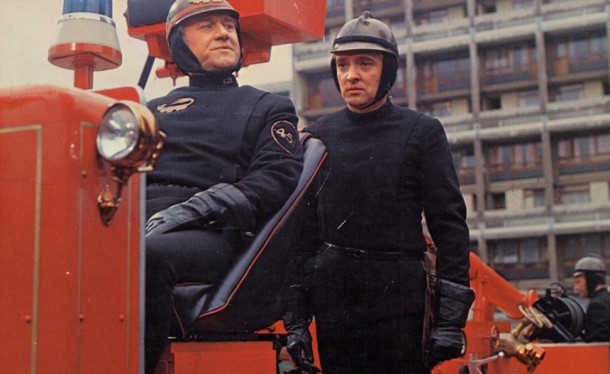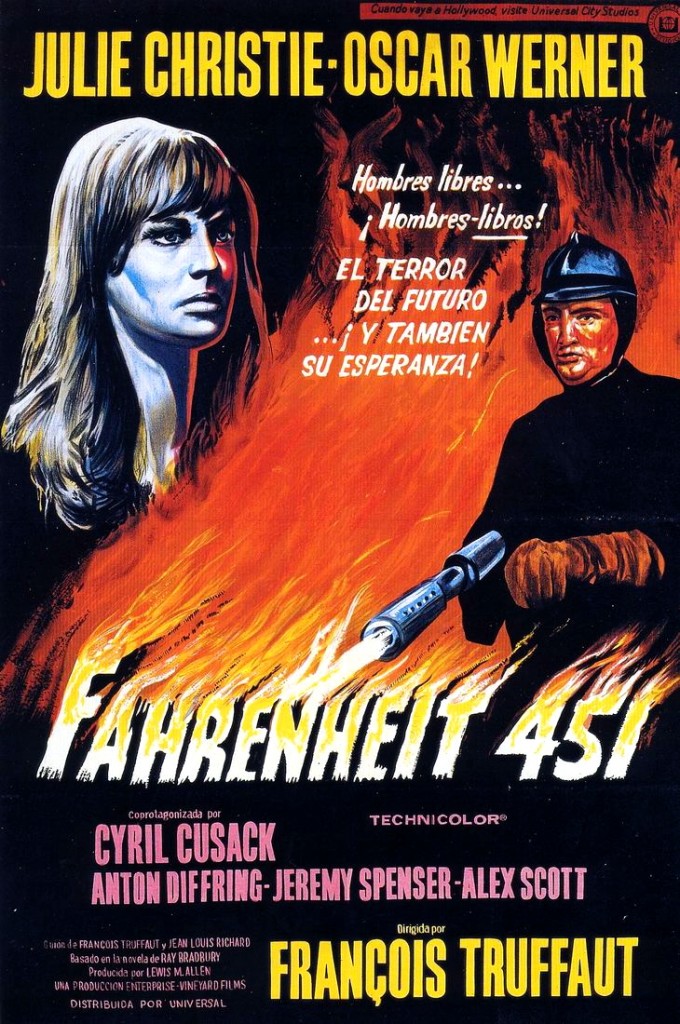
Dir: Francois Truffaut |Cast: Julie Christie, Oskar Werner, Cyril Cusack, Anton Diffring | Sci-fi Drama | 112′
One of the many pleasures of Truffaut’s adaptation of Ray Bradbury’s Fahrenheit 451 has become the power of the bibliophile. When the fireman of the future turn their flame-throwers on a pile of 1950/60’s paperbacks (it’s now over fifty years since Truffaut chose them for the film) their book covers appear achingly nostalgic, to older cineastes. Many of these retro Penguins and Pelicans still turn up in charity shops and though it hasn’t come to pass that our government will destroy them, maybe, just maybe, instead of becoming ash, they remain unsold and unread?
It’s fascinating to watch Fahrenheit 451 in our social-media age when more time is spent reading words on screens rather than on paper. Technology has ‘burnt’ into our reading behaviour making a ban on books almost unnecessary. We’ve ‘freely’ chosen, assisted by advertising, to absorb information on computers, TV and film over experiencing knowledge gleaned from the inner life of books of fiction or philosophy.
 Fahrenheit 451 depicts large television screens (a prophetic novelty in 1966 that we can now easily purchase) that in Truffaut’s ‘future’ are removed of word content in the form of credits or announcements. Our miniaturised phone screens, tablets and laptops, so commonplace in 2017, are never seen. Nor is any character depicted taking a selfie. The film’s routine narcissism consists of people without mobile devices, travelling on trains and hugging or touching their clothed selves, in a sad auto-erotic manner, indicating that clinging to a vestige of self-love is a last resort in a society where no one looks happy, and therefore is disinclined to reflect this on film.
Fahrenheit 451 depicts large television screens (a prophetic novelty in 1966 that we can now easily purchase) that in Truffaut’s ‘future’ are removed of word content in the form of credits or announcements. Our miniaturised phone screens, tablets and laptops, so commonplace in 2017, are never seen. Nor is any character depicted taking a selfie. The film’s routine narcissism consists of people without mobile devices, travelling on trains and hugging or touching their clothed selves, in a sad auto-erotic manner, indicating that clinging to a vestige of self-love is a last resort in a society where no one looks happy, and therefore is disinclined to reflect this on film.
Truffaut has claimed that Fahrenheit 451 is not science fiction. This is true in the sense that the technological menace of the book’s mechanical hound, and the horribly graphic manner in which would-be suicides are vacuumed of any depression, is absent. But Ray Bradbury, allowing for his technological terrors, was more of a poetic fantasist than a genre SF writer. Truffaut attempted to convey threats to intimacy (Fahrenheit 451 is more to do with repression and denial of human closeness). And Bradbury, also mindful of loss, is as differently soulful about that as Truffaut.
Guy Montag (Oskar Werner) discovers that after reading his first book, Dickens’s David Copperfield, he is re-born (“Chapter one. I am born. Whether I shall turn out to be the hero of my own life or whether that station will be held by anybody else these pages must show.”) His wife Linda (Julie Christie) discovers his crime and betrays Montag by informing the captain of the Fire Service (Cyril Cusack). Once they discover Montag’s secret hoard of books, Montag kills the captain, burns his room and escapes to the country to join the book people, who have each chosen a book to preserve for future generations. In Montag’s case it’s Poe’s Tales of Mystery and Imagination. The formerly placid and neutral Montag is to be transformed by symbolic tales depicting morbid states of catalepsy, hallucination and terror.
On my 4th viewing of Fahrenheit 451 I was much more aware of the film’s lightly humorous tone, making for a telling picture of social conformity: particularly this absurd exchange between Montag and the captain.
The Captain: By the way, what does Montag do on his day off duty?
Guy Montag: Not much, sir, just mow the lawn.
The Captain: And what if the law forbids it?
Guy Montag: Just watch it grow, sir.
Or the lovely in-joke announcement, by one of the book people, who’s preserving his text, in his memory, in order to survive its physical destruction.
Book Person: And I’m The Martian Chronicles by Ray Bradbury.
Whether by accident or design, the film’s book titles take on their own filmic pattern of meaning. I’m sure film students have written essays and published theses, on the trajectory of key books in Truffaut’s film, relating to the moral awakening of Montag. The first book that we see burning is Don Quixote (A story of a man pursuing illusions) then The Moon and Sixpence (A story of a man renouncing the conventions of society to become an artist) and David Copperfield (A story of a man who wants to determine his own fate.) All can be viewed as stages in Montag’s development from destroyer to creator, fireman made lover slowly seduced by his books.
The obedient state servant rejects a “zombie” (Montag’s word) society. Fireman burns books. Fireman reads and comes to revere books. Fireman becomes his freely chosen book. “Kerosene is a perfume” says Montag, explaining his book burning work, to Clarisse (Julie Christie doubling up as wife alter-ego and book person). Interestingly Truffaut’s film has no equivalent line of dialogue to suggest that the smell of a book’s pages become Montag’s preferred love perfume.
If there are flaws in Fahrenheit 451 they centre round some occasionally stilted dialogue. (Though this can be viewed as the natural result of a highly controlled zombiefied society plus Truffaut’s lack of English over co-writing the screenplay). And when the book people begin to appear near the end and start to introduce themselves – for example (“I am Pride and Prejudice Book I and I am Pride and Prejudice book 2” ) you immediately think what a great idea but not quite worked out properly. Then a miracle occurred. During the shooting of the film, it went and snowed. As the snow falls people walk back and forth, reciting chapters to themselves, and we experience eloquent screen poetry – greatly enhanced by Bernard Herrmann’s touching music.
Fahrenheit 451 was deeply unappreciated by audiences and critics in 1966. Today its menacing charm both excites and disturbs. This is a world as lyrical as Truffaut’s earlier films: though now beguiling us with a melancholic dystopia: our desperate attempts to recover a sense of self – even if fulfilment of feeling is most tenderly realised in love’s surrender to the printed word. Alan Price © 2017
NOW AVAILABLE ON BLURAY